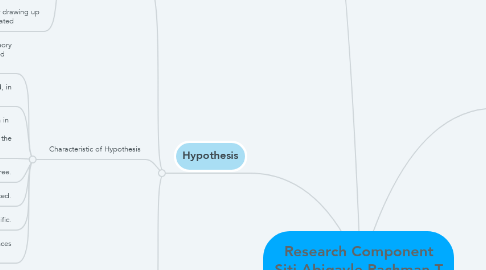
1. Variables
1.1. 3 Kinds of Variables Group
1.1.1. Free variables and bound variables
1.1.2. Active variables and attribute variables
1.1.3. Continuous variables and category variables
1.2. Use of Variables
1.2.1. For Hypothesis
1.2.2. To prepare tools and methods data collection
1.2.3. To prepare analysis/processing methods data
2. Hypothesis
2.1. Uses of Hypothesis
2.1.1. A. To test the theory,
2.1.2. B. Encouraging the emergence of theory,
2.1.3. C. Explaining social phenomena,
2.1.4. D. As a guideline for directing research,
2.1.5. E. Provide a framework for drawing up conclusions that will generated
2.2. Characteristic of Hypothesis
2.2.1. A. The hypothesis is derived from a theory compiled to explaining the problem and stated in the propositions.
2.2.2. B. The hypothesis must be clearly stated, in the correct terms and operationally
2.2.3. C. The hypothesis states the variation in value so that it can be measured empirical and provide an overview of the phenomenon researched
2.2.4. D. The hypothesis should be value-free.
2.2.5. E. The hypothesis must be tested.
2.2.6. F. The hypothesis must be specific.
2.2.7. G. The hypothesis should state differences or relationships between variables.
2.3. Stages of Making Hypothesis
2.3.1. Problem determintation
2.3.2. Preliminary Hypothesis
2.3.3. Fact Gathering
2.3.4. Hypothesis Formulation
2.3.5. Hypothesis testing
2.3.6. Application
3. Population and Samples
3.1. Sampling Technique
3.2. Non Probability Sampling
4. Problems
4.1. Sources
4.1.1. Observation of the problem is not clear
4.1.2. Deed of Theory
4.1.3. Research Results Decisions
4.1.4. Social Issues
4.1.5. Personal Experience
4.2. Type of Problems
4.2.1. Descriptive Problems
4.2.2. Comparative Problems
4.2.3. Associative Problems
4.3. 3 Things to Identify the Problem
4.3.1. Essential
4.3.2. Urgent
4.3.3. Benefit of The Problem If Resolved
5. Scientific Theory
5.1. 3 Types of Theory
5.1.1. Inductive Theory
5.1.2. Deductive Theory
5.1.3. Functional Theory
5.2. Uses of Theory
5.2.1. Provide patterns in the data interpretation process
5.2.2. Linking one study to another
5.2.3. Help researchers find a conceptual framework
6. Data
6.1. by Sources
6.1.1. 1.Primary Data
6.1.2. 2. Secondary Data
6.2. by Characteristic
6.2.1. Quantitative Data
6.2.2. Qualitative Data
